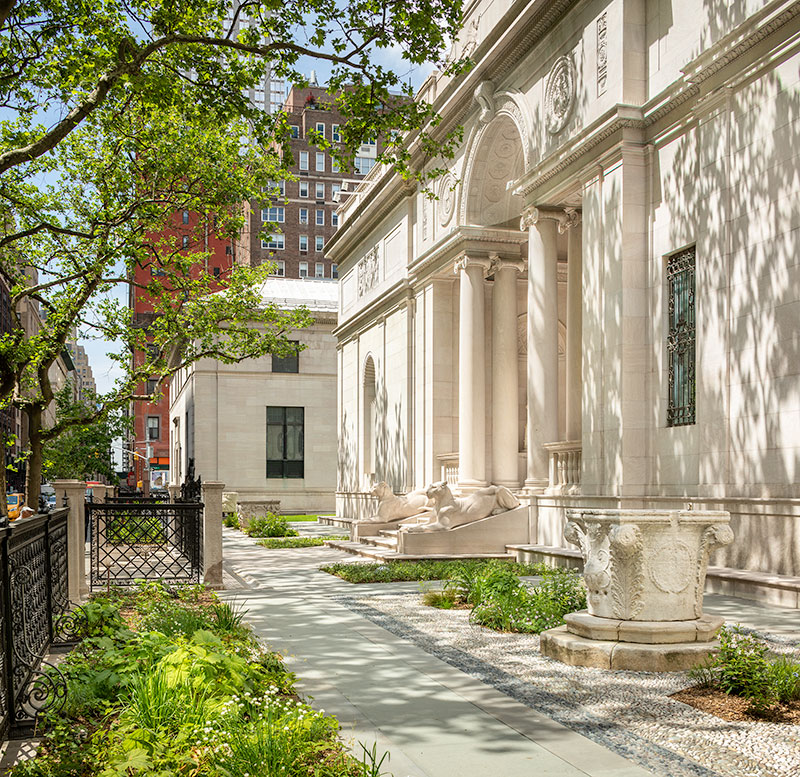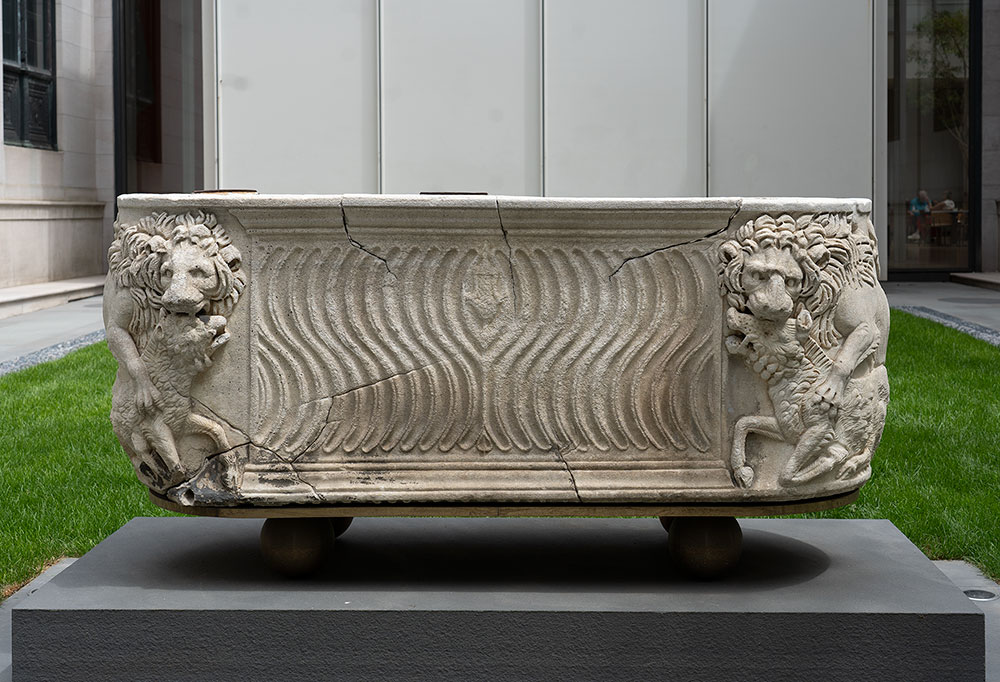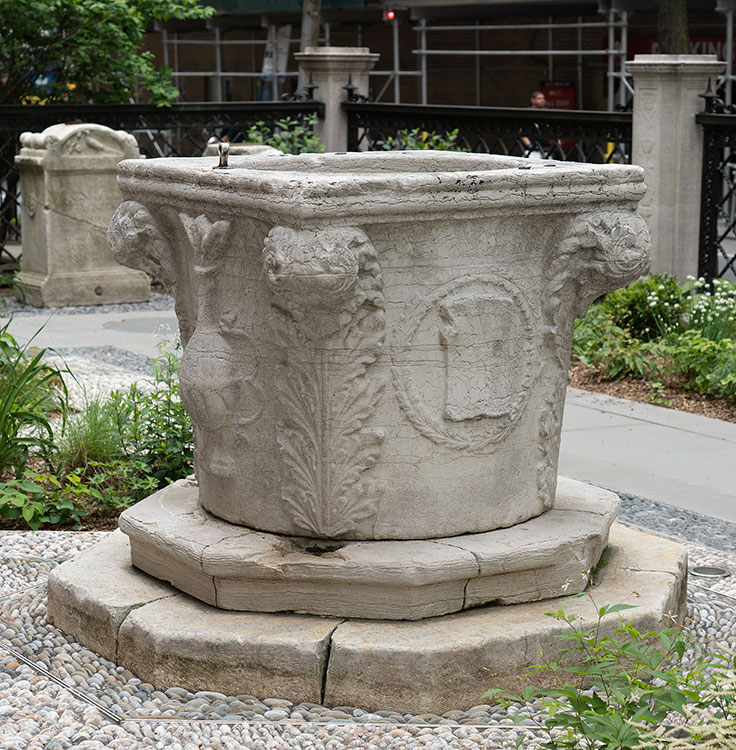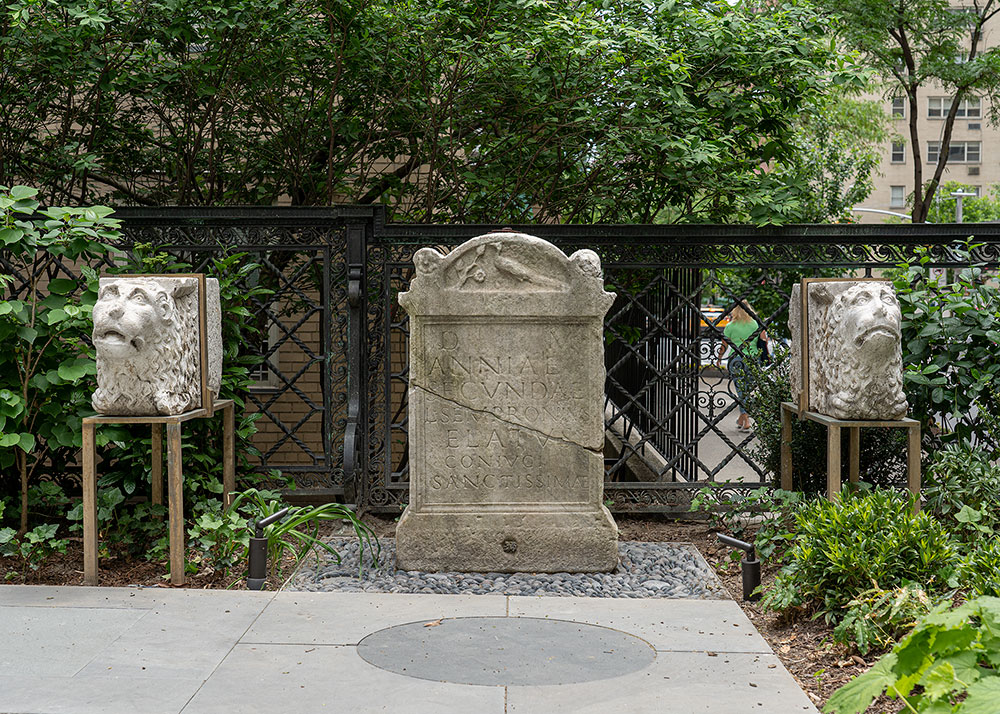Stop 55. The Garden

Jessica Ludwig, Deputy Director
Following Renzo Piano’s shift of the museum’s entrance from 36th Street to Madison Avenue, the exterior of J. Pierpont Morgan’s Library was not as prominent a part of a visit to the Morgan. A project begun in 2016 and completed in 2022 aimed to revitalize this part of the campus and enable visitor access to the site through a restoration of the building’s exterior and a rethinking of the surrounding landscape.
Landscape designer Todd Longstaffe Gowan developed a plan that respects the structures created by McKim and Piano while encouraging engagement with the architecture and opening up new spaces for programming. A generous lawn sweeps across the space between the Annex and the Library. Paths of bluestone, set in patterns that derive from the Library’s floor and exterior paving, provide a fully accessible surface for garden visitors. Elegant pebble work and beds of periwinkle flanking the Library’s loggia add texture and color. Incorporated into the newly designed garden are several antiquities collected by Morgan which were intended for outdoor display. A significant component of the project is new lighting, which will enhance the building’s presence at night and whose subdued design refers to the Library’s origin as a private space.
See video: Restoration of J. Pierpont Morgan's Library: Garden Development
Stop 56. Garden Sculpture

Sarcophagus
Roman
Ca. 275
Purchased by Pierpont Morgan before 1913.
Deirdre Jackson, Assistant Curator of Medieval and Renaissance Manuscripts
At the center of the lawn outside the Thaw Gallery sits a Roman sarcophagus, which dates to the third century, during the time of the Roman Empire. This lenos, or tub-shaped, sarcophagus is decorated with S-shaped grooves that resemble a strigil, the curved metal blade used by athletes to scrape dirt and oil from their bodies. The ends of the stone container feature lions attacking their prey, a popular motif for funerary art. Roman sarcophagi would have been placed inside a mausoleum, with the undecorated back against the wall.
In 1912, Pierpont Morgan engaged Beatrix Jones (later Beatrix Farrand), to design a garden for the space behind his home and library. The garden featured antiquities positioned on the lawn and as focal points along pathways. Todd Longstaffe-Gowan has reprised the spirit of the earlier garden, embedding several antique marble sculptures acquired by Morgan among the pebbled paths and on the lawn.
Stop 57. Well-Head

Venetian
15th century
Purchased by Pierpont Morgan, 1912.
This well-head is thought to be the work of a fifteenth-century Venetian sculptor. It bears the coat of arms of the Morosini family, a celebrated Venetian clan that gave rise to various doges and diplomats. The family’s most notorious descendant, however, was Francesco Morosini, who in 1687 destroyed the Parthenon and plundered Athens for antiquities.
Pierpont Morgan acquired the marble on June 13, 1912, from the Venetian bookdealer Ferdinando Ongania, who shipped it to New York. Librarian Belle Greene noted on the invoice that it was intended for the Library, indicating that Morgan must have purchased it to embellish the grounds.
Early designs for the building show fountains where this and another well-head are now placed, but a photograph taken before 1924 shows at least one of the well-heads already installed in the spot. Landscape architect Todd Longstaffe-Gowan respected the historic placement of these objects when designing the pebble-work, paths, and beds that flank the walkway to Morgan’s Library.
Stop 58. Grave marker of Annia Secunda

Roman
Ca. 100-200
Purchased by Pierpont Morgan before 1913.
Deirdre Jackson, Assistant Curator of Medieval and Renaissance Manuscripts
At the end of this bluestone path sits a Roman grave marker, or stele. The stone commemorates the life of an individual named Annia, who was a freedwoman, a low-status freeborn woman in ancient Rome. It was dedicated by her husband, Lucius Sempronius. The inscription reads: To the divine spirits. Lucius Sempronius Elatus (made this) for his most pious spouse, Annia Secunda. The back of the stone bears a second dedicatory offering: To the divine spirits, for Lollia Staphyle. The stele dates to the second century, a time of political upheaval and prolonged crisis for the empire.